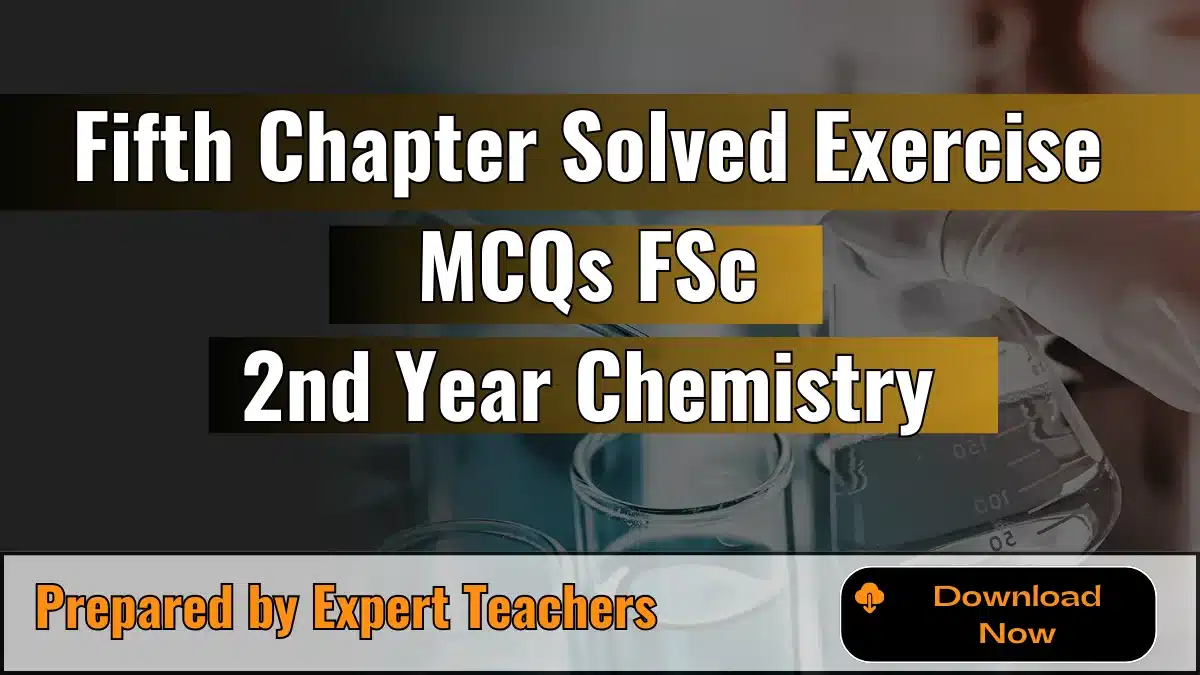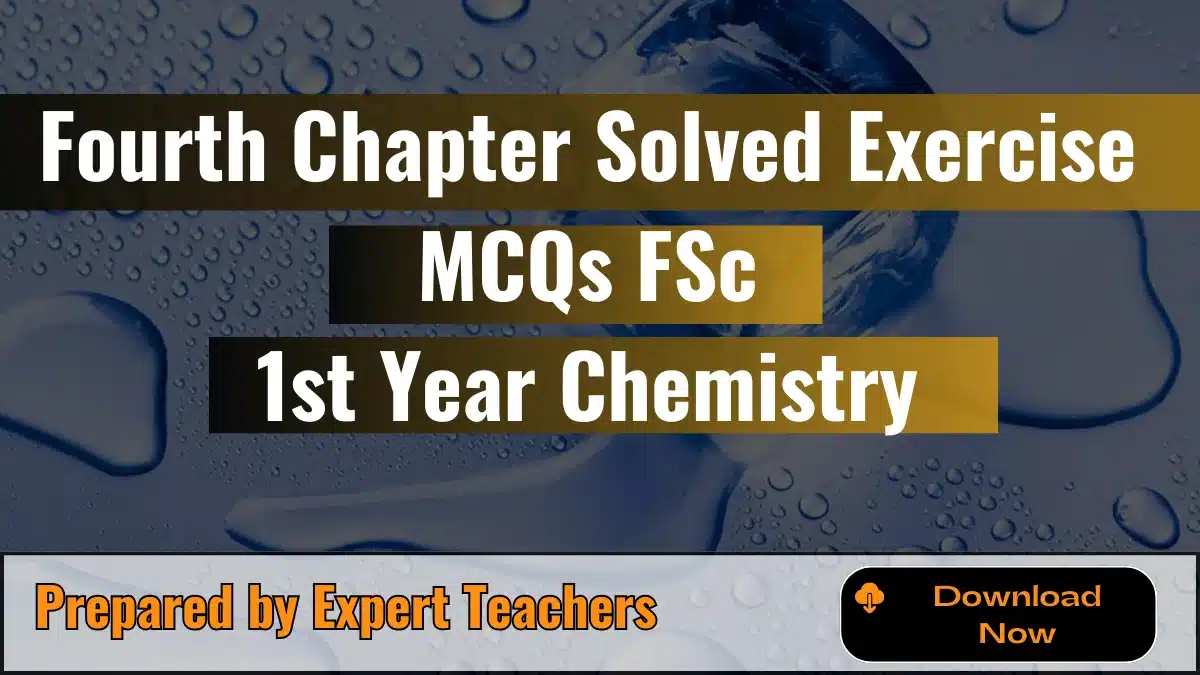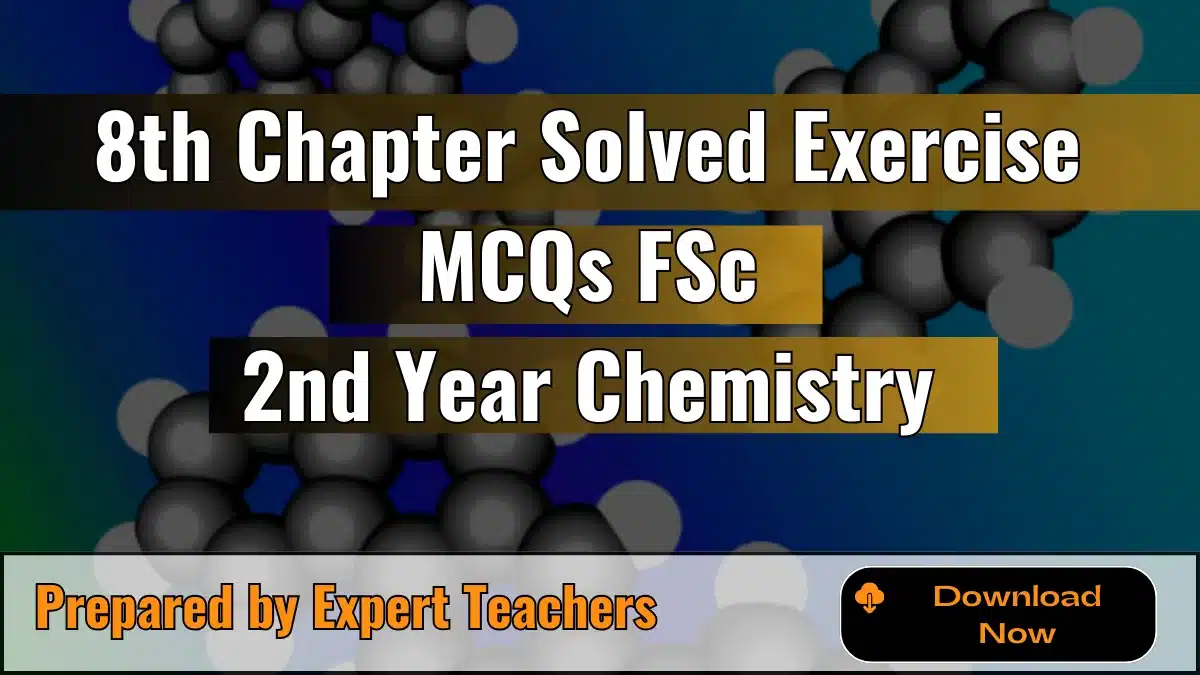9th Chapter Solved Exercise MCQs of FSC Second Year Chemistry
The 9th Chapter Solved Exercise MCQs of FSC 2nd-year Chemistry provides a complete set of solved multiple-choice questions (MCQs). Each MCQ comes with a brief explanation to help you understand the correct answer. These solutions are designed to support students in preparing for their exams, making complex concepts easier to grasp and ensuring a solid foundation for success.
9th chapter solved MCQs with explanation
1. The benzene molecule contains:
(a) Three double bonds
(b) Two double bonds
(c) One double bond
(d) Delocalized π-electron charge
Explanation: Option (a) is correct. Because the obvious thing to assume is that each carbon atom forms a double bond with another carbon atom, meaning each carbon atom has four bonds in total. This gives three double bonds in the whole molecule; this representation of benzene is called the Kekulé structure.
2. Aromatic hydrocarbons are the derivatives of:
(a) normal series of paraffins
(b) alkene
(c) benzene
(d) cyclohexane
Explanation: Option (c) is correct. Because Aromatic hydrocarbons are chemicals that are based on benzene. Benzene has a special ring structure with six carbon atoms and is known for its stability. Aromatic hydrocarbons are derived from this benzene ring or similar ring structures. In simpler terms:
- Normal series of paraffins are alkanes like methane or ethane, which don’t have the benzene ring.
- Alkenes have double bonds between carbon atoms, not the benzene ring.
- Cyclohexane is a six-carbon ring without the special benzene structure. So, aromatic hydrocarbons come from benzene.
3. Which of the following acid can be used as a catalyst in Friedel-Crafts reactions?
(a) AlCl₃
(b) HNO₃
(c) BeCl₂
(d) NaCl
Explanation: Option (a) is correct. AlCl₃ is a strong Lewis acid. Because it facilitates Friedel-Crafts reactions by accepting an electron pair and forming a reactive intermediate. This intermediate then reacts with the aromatic ring.
4. Benzene cannot undergo:
(a) substitution reactions
(b) addition reactions
(c) oxidation reactions
(d) elimination reactions
Explanation: Option (d) is correct. Because Benzene is stable and typically reacts through substitution (where one atom is replaced) or sometimes addition reactions. Oxidation reactions can happen with benzene derivatives, but elimination is not a common reaction for benzene.
5. Amongst the following, the compound that can be most readily sulphonated is:
(a) toluene
(b) benzene
(c) nitrobenzene
(d) chlorobenzene
Explanation: Option (a) is correct. Because Toluene is the most reactive towards sulphonation because the methyl group (–CH₃) is an electron-donating group that increases the electron density of the benzene ring. In comparison:
- Benzene is less reactive as it lacks substituents that enhance reactivity.
- Nitrobenzene is deactivated due to the electron-withdrawing nitro group (–NO₂).
- Chlorobenzene has a deactivating chloro group (–Cl), though it still provides some electron density. Therefore, toluene, with its electron-donating group, is the most readily sulphonated.
6. During nitration of benzene, the active nitrating agent is:
(a) NO₃
(b) NO₂⁺
(c) NO₂⁻
(d) HNO₃
Explanation: Option (b) is correct. During the nitration of benzene, the active nitrating agent is the nitronium ion (NO₂⁺). This ion is generated in situ by the reaction of nitric acid (HNO₃) with sulfuric acid (H₂SO₄). The nitronium ion is highly electrophilic and reacts with benzene to form nitrobenzene. The other options are not the active nitrating agents in this process.
7. Which compound is the most reactive one:
(a) benzene
(b) ethene
(c) ethane
(d) ethyne
Explanation: Option (d) is correct. Because Ethyne (C₂H₂) is the most reactive it has a triple bond between the two carbon atoms. This triple bond is highly reactive due to its high bond energy and the presence of multiple pi bonds.
Benzene is less reactive because of its stable aromatic ring, ethene has a double bond which is less reactive than a triple bond, and ethane has only single bonds, making it the least reactive.
8. The electrophile in aromatic sulphonation is:
(a) H₂SO₄
(b) HSO₄
(c) SO₃
(d) SO₃⁺
Explanation: Option (d) is correct. Because in aromatic sulphonation, the reactive part that attacks the benzene ring is SO₃⁺. This ion is made from sulfur trioxide (SO₃) when it’s mixed with sulfuric acid (H₂SO₄). So, SO₃⁺ is the actual electrophile that reacts with the aromatic ring.
9. Aromatic compounds burn with sooty flame because:
(a) They have high percentage of hydrogen.
(b) They have a ring structure.
(c) They have high percentage of carbon.
(d) They resist reaction with air.
Explanation: Option (c) is correct. Aromatic compounds, such as benzene, have a high percentage of carbon compared to hydrogen. When these compounds burn, they often produce a sooty flame because the high carbon content leads to incomplete combustion in the presence of limited oxygen. This incomplete combustion produces a lot of soot (carbon particles) instead of burning completely into carbon dioxide and water.
10. The conversion of n-hexane into benzene by heating in the presence of Pt is called:
(a) Isomerization
(b) Aromatization
(c) Dealkylation
(d) Rearrangement
Explanation: Option (c) is correct. Because Dealkylation is a process where an alkyl group is removed from a molecule. In this case, n-hexane, which is an alkane with six carbon atoms, is converted into benzene, an aromatic hydrocarbon with six carbon atoms arranged in a ring. This transformation involves removing alkyl groups and forming a benzene ring. Aromatization refers to forming an aromatic ring, but in the context of this conversion, dealkylation is the more accurate term.







Leave a Reply